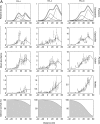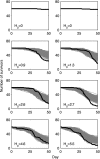Epizootics of wild fish induced by farm fish
- PMID: 17021017
- PMCID: PMC1591297
- DOI: 10.1073/pnas.0603525103
Epizootics of wild fish induced by farm fish
Abstract
The continuing decline of ocean fisheries and rise of global fish consumption has driven aquaculture growth by 10% annually over the last decade. The association of fish farms with disease emergence in sympatric wild fish stocks remains one of the most controversial and unresolved threats aquaculture poses to coastal ecosystems and fisheries. We report a comprehensive analysis of the spread and impact of farm-origin parasites on the survival of wild fish populations. We mathematically coupled extensive data sets of native parasitic sea lice (Lepeophtheirus salmonis) transmission and pathogenicity on migratory wild juvenile pink (Oncorhynchus gorbuscha) and chum (Oncorhynchus keta) salmon. Farm-origin lice induced 9-95% mortality in several sympatric wild juvenile pink and chum salmon populations. The epizootics arise through a mechanism that is new to our understanding of emerging infectious diseases: fish farms undermine a functional role of host migration in protecting juvenile hosts from parasites associated with adult hosts. Although the migratory life cycles of Pacific salmon naturally separate adults from juveniles, fish farms provide L. salmonis novel access to juvenile hosts, in this case raising infection rates for at least the first approximately 2.5 months of the salmon's marine life (approximately 80 km of the migration route). Spatial segregation between juveniles and adults is common among temperate marine fishes, and as aquaculture continues its rapid growth, this disease mechanism may challenge the sustainability of coastal ecosystems and economies.
Conflict of interest statement
The authors declare no conflict of interest.
Figures




Comment in
-
Salmon-farming impacts on wild salmon.Proc Natl Acad Sci U S A. 2006 Oct 17;103(42):15277. doi: 10.1073/pnas.0607419103. Epub 2006 Oct 9. Proc Natl Acad Sci U S A. 2006. PMID: 17030817 Free PMC article. No abstract available.
References
-
- Jackson JBC, Kirby MX, Berger WH, Bjorndal KA, Botsford LW, Bourque BJ, Bradbury RH, Cooke R, Erlandson J, Estes JA, et al. Science. 2001;293:629–638. - PubMed
-
- Hutchings JA. Nature. 2000;406:882–885. - PubMed
-
- Pauly D, Christensen V, Guenette S, Pitcher TJ, Sumalila UR, Walters CJ, Watson R, Zeller D. Nature. 2002;418:689–695. - PubMed
-
- Pauly D, Alder J, Bennett E, Christensen V, Tyedmers P, Watson R. Science. 2003;302:1359–1361. - PubMed
Publication types
MeSH terms
LinkOut - more resources
Full Text Sources
Other Literature Sources

